Introduction
Background
Gingivitis is an inflammatory process limited to the mucosal epithelial tissue surrounding the cervical portion of the teeth and the alveolar processes. Gingivitis has been classified by clinical appearance (eg, ulcerative, hemorrhagic, necrotizing, purulent), etiology (eg, drug-induced, hormonal, nutritional, infectious, plaque-induced), and duration (acute, chronic). The most common type of gingivitis is a chronic form induced by plaque. Gingivitis is shown in the image below.
Moderate chronic gingivitis. Note that the papillae are edematous and blunted. They may bleed with brushing. Note areas of edema overlying some of the root areas. Pallor is seen in these areas. Image courtesy of Robert J. Lindberg, DMD.
Compare the image above to a healthy mouth, below.
Healthy mouth and gingiva. Note the healthy light pink color of the gingiva. The intradental papillae are sharp and fill the intradental space. No local edema is present. Image courtesy of Robert J. Lindberg, DMD.
Acute necrotizing ulcerative gingivitis (ANUG, ie, trench mouth) is an acute infectious gingivitis. The term trench mouth was coined in World War I when ANUG was common among trench-bound soldiers.
Pathophysiology
The most common type of gingivitis involves the marginal gingiva and is brought on by the accumulation of microbial plaques in persons with inadequate oral hygiene. Gingivitis proceeds through an initial stage to produce early lesions, which then progress to advanced disease.
The initial stage of an acute exudative inflammatory response begins within 4 or 5 days of plaque accumulation. Both gingival fluid and transmigration of neutrophils increase. Deposition of fibrin and destruction of collagen can be noted in the initial stage. At approximately 1 week, transition to early lesions is marked by the change to predominately lymphocytic infiltrates. Monocytes and plasma cells also may be present. With time, lesions become chronic and are characterized by the presence of plasma cells and B lymphocytes. As chronic local inflammation progresses, pockets develop where the gingiva separates from the tooth. These pockets deepen and may bleed during tooth brushing, flossing, and even normal chewing. As this persistent inflammation continues, periodontal ligaments break down and destruction of the local alveolar bone occurs. Teeth loosen and eventually fall out.
ANUG is a completely different syndrome caused by acute infection of the gingiva with organisms such as Prevotella intermedia, alpha-hemolytic streptococci, Actinomyces species, or any of a number of different oral spirochetes. ANUG may result in accelerated destruction of affected tissues, as well as local or systemic spread of infection.
Noma (cancrum oris) is a syndrome in which ANUG spreads beyond the gingiva. The infection invades local tissues of the mouth and face.
Frequency
United States
Frequency is difficult to determine because of the lack of agreement on measurement criteria. Many people believe that gingivitis begins in early childhood and that 9-17% of children aged 3-11 years have gingivitis. At puberty, prevalence rises to 70-90%. In recent years, periodontal disease, the endpoint of chronic gingivitis, slowly has decreased among adult Americans.
ANUG may be a clinical problem in immunocompromised patients during chemotherapy. Gingivitis and resulting periodontal disease are seen more frequently in patients with either diabetes or HIV.
International
Studies in Australia, Sweden, England, and Switzerland report gingivitis in 48-85% of children aged 3-6 years, but whether this range reflects population differences or whether it is due to different criteria used to define the disease is difficult to know. In adolescence, incidence around the world is comparable to US data (70-90%). ANUG may be found in areas where those at risk, particularly children, face poor living conditions. Recent publications show several cases in areas such as Nigeria, where ANUG and noma were observed in children younger than 14 years.1
Mortality/Morbidity
Periodontal disease has been shown in some studies to be an associated factor in coronary artery disease (CAD) and cerebrovascular disease/ischemic stroke.2,3,4 This association with CAD has not been shown in all studies. Periodontal disease in pregnancy has been associated with an increase in preterm birth and adverse pregnancy outcomes.5 Periodontitis coexisting with bacterial vaginosis is associated with higher vaginal bacterial counts.6 Periodontitis in a person with diabetes has been associated with exacerbation of both conditions.7,8 Treatment of periodontitis in persons with type 2 diabetes has improved glycemic control.9
Severe periodontal disease, as shown in the image below, may occur.
Severe periodontal disease. Loss of the gingival tissue is seen, making the teeth appear long. Even more effacement of the papillae is present. Heaped up ridges are observed in the areas overlying the roots. Image courtesy of Robert J. Lindberg, DMD.
Chronic gingivitis leads to tooth loss. ANUG may progress into the local soft tissues of the mouth, resulting in noma or cancrum oris, or may spread hematogenously to any other part of the body.
Sex
- Gingivitis is slightly more prevalent in males than in females because females tend to have better oral hygiene.
Age
- Adults are most commonly affected.
- Children from sub-Saharan regions of Africa may be at risk for ANUG because of poor living conditions.
Clinical
History
Historical findings depend on whether the patient has chronic gingivitis or ANUG.
- Chronic gingivitis
- The most common complaint is bleeding gums. The patient usually notices this when toothbrushing or flossing.
- Bleeding may be associated with eating, especially foods with a hard consistency, such as apples or crusted bread. These foods may rub against gums.
- Acute necrotizing ulcerative gingivitis
- Apparently spontaneous bleeding or bleeding in response to very minimal local trauma may occur.
- ANUG also may produce local pain, malaise, and alterations in taste, such as a metallic flavor.
- ANUG may produce foul breath.
Physical
- Chronic gingivitis
- Patients have minimal physical findings aside from local findings at the dental-gingival margins.
- Gingival pockets may be detected with a periodontal probe. However, the pocket depth may be overestimated when periodontitis is present and underestimated in healthy gums.
- Mild bleeding from the gum margins may occur with any manipulation.
- Acute necrotizing ulcerative gingivitis
- Fever, halitosis, marked gingival edema, and ulceration, especially in the interdental papillae, may be present.
- A grey pseudomembrane may be present.
- Infection may spread to adjacent soft tissues of the mouth, with noticeable erythema, edema, tenderness, and induration of affected areas.
- Reaction to oral contraceptives (see Causes)
Causes
- Although bacteria play a role in all forms of gingivitis, the primary cause of chronic gingivitis is inadequate oral hygiene.
- Risk factors
- Use of tobacco or ethanol is thought to be a risk factor.
- Immune incompetence is observed more frequently in HIV-infected children. As their CD4 counts decline, incidence of gingivitis may increase. Diabetes mellitus increases the risk of gingivitis and periodontitis.
- Drug-induced causes
- The list of drugs that cause gingivitis and gingival bleeding is extensive.
- Gingival bleeding may occur with the use of anticoagulants and fibrinolytic agents.
- Phenytoin, oral contraceptive agents, and calcium channel blockers may cause gingival hyperplasia.
- Gingivitis has been observed with use of protease inhibitors (eg, saquinavir, ritonavir), vitamin A and analogues, danazol, pentamidine, misoprostol, methotrexate, and gold compounds.
- Gingivostomatitis has been observed in exposure to arsenic, gold, bismuth, mercury, nickel, sulfur dioxide, lead, thallium, zinc, methyl violet, and topical chlorhexidine.
- Acute necrotizing ulcerative gingivitis
- Acute necrotizing infection may occur as a complication of chronic gingivitis in situations in which hygiene is abandoned completely or host defenses are weakened.
- ANUG is the result of soft tissue invasion by ubiquitous organisms and is not believed to be contagious.
- It is a risk wherever poor sanitation, diet, or oral hygiene is present.
- Living near livestock is an additional risk factor.
- Other causes
- Inadequate plaque removal
- Blood dyscrasias
- Allergic reactions
- Chronic debilitating disease
- Poor nutrition
- Lack of periodic dental examinations
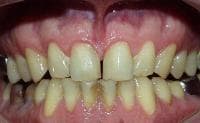
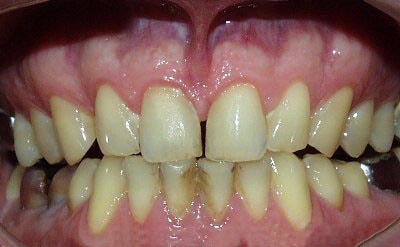
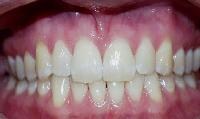
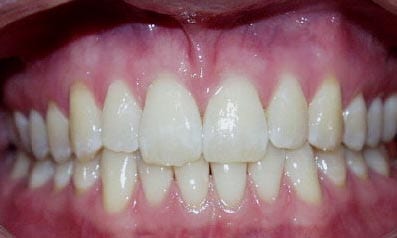
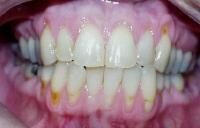
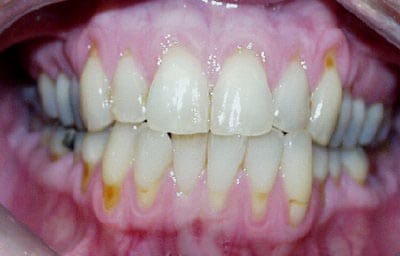

ALL THANKS TO DR WILLIAMS FOR THE GREAT DEED HE HAVE DON FOR MY DAUGHTER?
Trả lờiXóaMy daughter suffered from a terrible gingivitis for more than 23 years which started after she turned 5 we all thought it will end but got even worse as days went by. We tried all several treatments and therapy prescribed by various doctors we met but to no avail, she have always complain of teeth pain because of the pus between her teeth and gums. She usually tells me she fee pain when chewing. This were steady pains that disrupted her entire life, and she slept less because of this.It was during a casual conversation with a friend that i learned about dr Williams herbal medicine I was able to contact him on his email address. and give him all the necessary information that he needed,few day later he sent me the herbal portion and his medicine was able to restore her teeth back to normal and she is very okay now without any side effects whatsoever. If you have any teeth disease , do not hesitate to contact him on drwilliams098765@gmail.com for advice and for his product. I hope this also helps someone out there.
Did you know you can create short urls with AdFly and make $$$$ for every visitor to your shortened links.
Trả lờiXóaI was diagnose with genital warts since 2012 i have be taking lot treatment and all i got is outbreak. in 2015 I gave up the treatment because I can't continues wasting time and money on treatment at the end it will not cure me. about 6 weeks ago i did natural research online I had So many people talking good about natural remedy, after the research i was recommended to Dr onokun, And I wrote to him through his email and told him my problem after some conversations with him he gave me natural treatment after 1 week Dr onokun treated me i got cured permanently. and i went to see my doc he confirmed that the diseases has gone out from my body. every patients should know there is 100% natural hpv cure. contact Dr onokun his email address: dronokunherbalcure@gmail.com
Trả lờiXóaThe best cure for gingivitis thaoduocsucmiengyentu.vn
Trả lờiXóaHere is a great herbal doctor who cured me of Hepatitis B. his name is Dr. Imoloa. I suffered Hepatitis B for 11 years, I was very weak with pains all over my body my stomach was swollen and I could hardly eat. And one day my brother came with a herbal medicine from doctor Imoloa and asked me to drink and I drank hence there was no hope, and behold after 2 week of taking the medicine, I started feeling relief, my swollen stomach started shrinking down and the pains was gone. I became normal after the completion of the medication, I went to the hospital and I was tested negative which means I’m cured. He can also cure the following diseases with his herbal medicine...lupus, hay fever, measles, dry cough, diabetics hepatitis A.B.C, mouth ulcer, mouth cancer, bile salt disease, fol ate deficinecy, diarrhoea, liver/kidney inflammatory, eye cancer, skin cancer disease, malaria, chronic kidney disease, high blood pressure, food poisoning, parkinson disease, bowel cancer, bone cancer, brain tumours, asthma, arthritis, epilepsy, cystic fibrosis, lyme disease, muscle aches, fatigue, muscle aches, shortness of breath, alzhemer's disease, acute myeloid leukaemia, acute pancreatitis, chronic inflammatory joint disease, Addison's disease back acne, breast cancer, allergic bronchitis, Celia disease, bulimia, congenital heart disease, cirrhosis, constipation, fungal nail infection, fabromyalgia, (love spell) and many more. he is a great herbalist man. Contact him on email; drimolaherbalmademedicine@gmail.com. You can also reach him on whatssap- +2347081986098.
Trả lờiXóa